Incipient Technologies: Desorption and Thermal Desorption Techniques
LCGC North America
Nearly a dozen incipient technologies have appeared in recent years. Which will survive? Which will find extensive, robust usage as did electrospray ionization? Which are fated to become footnotes in mass spectrometry practice?
The number of atmospheric-pressure sampling techniques grew exponentially in the past few years. We have not seen such a concerted effort at innovation since the early 1990s, when electrospray was becoming the commercial prospect it is today. Back then, techniques like particle-beam mass spectrometry (MS), atmospheric-pressure chemical ionization (APCI), fast-atom bombardment, and others vied for equal merit largely because analytical practitioners lacked experience using them.

Michael P. Balogh
Currently, nearly a dozen incipient technologies exist — MS techniques that are only now coming into view. Typically, when they emerge, such technologies stimulate interest among practitioners. Nevertheless, their commercialization is not yet widespread and the underlying functional principles of their newly filed patent applications are not yet completely understood. Yet if the past is prologue, it is safe to say that in coming years most incipient technologies will not withstand the rigors of commercialization. Which will survive? Which will find extensive, robust usage as did electrospray ionization (ESI) and APCI? Which are fated to become footnotes in MS practice, like particle-beam MS, a worthy technique that never quite achieved becoming an established utility for various reasons?
In most cases, new techniques today are developed and commercialized with an eye toward compelling, market needs such as food safety and (now) homeland security. In those areas, a need to reduce sampling time and simplify sample preparation couples with a need to achieve first-order results at the hands of users with relatively scant training.
Surface Sampling and Ionization
The techniques for surface sampling and ionization at atmospheric pressure are attractive alternatives to liquid chromatography (LC)–MS. A Chemical &Engineering News feature was devoted to the topic (Oct 8 issue, Taking Mass Spec into the Open, pubs.acs.org/cen/coverstory/85/8541cover.html) and the American Society of Mass Spectrometry (ASMS) organized the annual fall workshop "The Art of Open Air Ionization on Surfaces" (November 8 and 9, 2007, Philadelphia, Pennsylvania).These techniques provide reasonable expectations that the demand for a quantitative response with a broad range of compounds (or, at least, target compounds) can be met.
Dr. Gary Van Berkel and his coworkers in the Organic and Biological Mass Spectrometry group at Oak Ridge National Laboratory (Oak Ridge, Tennessee) have devoted much time investigating surface sampling and ionization techniques. Their website is a source of valuable information on the topic (www.ornl.gov/sci/csd/Research_areas/obms_group.html).
Figure 1 encapsulates some aspects of this discussion, associating related techniques by their fundamental properties including the overlapping combinations. Often, as the work evolves, the true nature of the mixed modes at work is revealed. For instance, more than 30 years after the introduction of APCI, there are a number of approaches using a variety of materials and means of desolvating the liquid flow owing to a complexity of underlying fundamental properties (though we suspect they are a mixture of nucleate boiling and Leidenfrost effects). Nevertheless, our relative ignorance does not inhibit our success using APCI for neutral and nonpolar analytes in place of ESI.
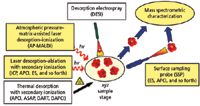
Figure 1: Surface sampling and chemical imaging under ambient conditions.
Desorption
Desorption electrospray ionization (DESI):www.prosolia.com/
Graham Cooks' group (Purdue University, West Lafayette, Indiana). First publication, Science 306, 471 (2004).
In desorption electrospray (DESI), a spray of energized liquid (the analyte-free output of an ESI probe) is aimed at an angle at an inert, flat surface on which an analyte was previously deposited. The technique is related functionally to LC in the most fundamental sense in that solubilization at the surface must occur first followed by electrospray-like production of ions.
Prosolia, Inc. (Indianapolis, Indiana), is primarily responsible for commercializing DESI, which it markets as the Omni Spray ionization source. The company's singular illustration of the potential of such a technique has been an effective icon representing the promise of the technology (Figure 2), depicting a finger held in front of the sprayer. The person whose finger is shown recently ingested loratidine, a metabolite of which is present in sweat and is seen in the MS spectrum.
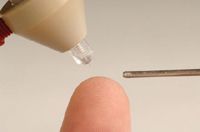
Figure 2: Surface sampling with DESI.
Thermal desorption with secondary ionization techniques: Applying heat to desorb analytes from a surface much like DESI followed by some additional means of ionization extends the techniques to a greater range of chemical diversity. Desorption atmospheric pressure chemical ionization (DAPCI), a variant of DESI that uses gas-phase ions generated by atmospheric pressure corona discharges of organic compounds, provides evidence for a heterogeneous phase (gaseous ion–absorbed analyte) charge transfer mechanism of DESI ionization in the case of explosives.
Direct ionization real time (DART)
Cody et al., Analytical Chemistry 77, 2297–2302 (2005).
A similar iconic figure has been seen in print depicting one of the DART inventors holding paper currency in front of the device to detect drugs of abuse coating the surface. A dry gas (usually helium or a mixture of gases) is introduced using a needle electrode, creating both charged particles and excited-state species (gaseous metastables) by glow discharge. The charged particles are filtered, leaving only metastables. The stream flows through a heated tube resulting in thermal desorption of the sample into the air. At room temperature and atmospheric pressure, ionization occurs at the probe exit.
Atmospheric pressure solids analysis probe (ASAP)
McEwen et al., Analytical Chemistry 77, 7826–7831 (2005). Also see the column dealing with these techniques in detail (1).
ASAP is a low-cost alternative to other direct atmospheric pressure ionization techniques like DART and DAPCI. The developers employ the existing "as manufactured" source enclosure and contend ASAP does not suffer from the current early design dilemma of DESI and DART which, being unenclosed, may expose the operator to some hazard. Hot desolvation gas (nitrogen) from an ESI or APCI probe vaporizes the sample similar to DART. The ASAP probe does not interfere with ESI or APCI operation, so switching between methods is near-instantaneous. ASAP appears to be especially useful on commercial, high-end, atmospheric pressure ionization mass spectrometers, which can perform accurate mass measurements and mass-selected fragmentation. It replaces solids probe work and is effective in analyzing volatiles and semivolatiles in tissue and other solid material samples such as these:
- Basil leaf — chemical changes were observed readily when the plant was grown under relatively cold, dark conditions.
- Polymer additives — at a higher temperature, many polymers thermally degrade, aiding in polymer identification.
- Drugs — detected in urine without any pretreatment or on currency simply by placing the corner of a note in the hot gas stream.
- Environmental contaminants — easily detects polynuclear aromatics.
At ASMS 2007, Tomany and Jarrell (2) demonstrated techniques based upon the well-characterized behavior of liquid carbon dioxide to expand rapidly out from a restricting orifice. That behavior harnesses the Joule–Thomson effect, producing particles of solid carbon dioxide. Tomany and Jarrell found that by directing the emerging carbon dioxide particles at a surface, they could desorb and ionize sample molecules on or off that surface. A conventional cylinder of carbon dioxide, like that often used for supercritical fluid chromatography, provided the liquid carbon dioxide.
Laser-Assisted and Other Techniques
Leaving aside those well-characterized laser desorption–ablation techniques that typically require extensive sample preparation and are therefore not fast analyses, a few in this area are nonetheless notable.
Atmospheric pressure, matrix-assisted, desorption–ionization (AP-MALDI): Interfacing MALDI with atmospheric-sampling time-of-flight (TOF) and trapping instruments simplifies and increases the versatility of atmospheric pressure ionization analyses. At the same time, the technique provides a softer ionization than vacuum-MALDI. Little fragmentation occurs because the ions generated are thermalized efficiently, so analyzing vacuum-sensitive samples such as tissues, gels, and analytes containing volatile solvents is possible (3–5).
Electrospray-assisted laser desorption–ionization (ELDI): ELDI decouples desorption from ionization, eliminating the requirement that a matrix facilitate both desorption and ionization. Without using a matrix, the technique simplifies sample preparation for the ionization of biomolecules and also for the multiple charging of mass spectra of intact proteins (6).
Plasma-assisted desorption–ionization (PADI): demonstrated at the 28th ICPIG (July 15–20, 2007, Prague, Czech Republic), developed at Hiden Analytical, Ltd. (Warrington, UK) is a surface technique, carried out at ambient conditions, which requires no surface preparation. A nonthermal radio frequency plasma is aimed at a surface where a desorption mechanism creates ions.
Some common attributes: These techniques share some demonstrated capability or near-term potential for spot sampling, line scans, or surface imaging. Typically, we foresee
- Analyses with minimal or no sample preparation, even with "dirty" samples.
- Direct sampling from a surface at ambient pressure
- Fast analyses, usually with but a few seconds between samples.
Of course, these representations are far from absolute. An obvious caveat applies: because the techniques are largely in an embryonic stage, they lack the robust qualities and finish we would expect in mature products. For instance, minimal sample carryover, where only the sample contacts a disposable surface, seems an intuitive benefit. Yet that benefit seems compound-specific. Van Berkel of Oak Ridge observed that, based upon his experience, some compounds with intermediate vapor pressure (like caffeine) exhibit carryover, perhaps due to variations in the transfer (hot, warm, cold spots in a transfer line, for instance).
Tracking emerging trends: From the nearly 3000 abstracts submitted to the ASMS conference each year we can deduce simple trends. In 2007, a simple word search returns 65 individual abstracts containing mentions for DESI — that versus 36 in 2006. In 2005, Cook's Purdue group and its associates submitted most of that year's 16 mentions. Interestingly, "ASAP," an acronym introduced by DuPont's Charles McEwen with the 2005 publication of his work developing the atmospheric pressure solids analysis probe returned 24 hits even though it is not a commercial entity on par with the others. (An indication perhaps of how astute the submitters are of current technology.) "DART," JEOL Corporation's direct-analysis, real-time acronym (Peabody, Massachusetts), returned 60, indicating considerable overlap in the early appreciation of those developing techniques.
Recent work by Prosolia using its DESI device on a TOF (Waters' LCT Premier) instrument indicates that even at this early stage, the DESI-TOF technique can analyze final product formulations effectively. In an application note, posted on the company's website (www.prosolia.com/pdf/LDPE.pdf), a low-density polyethylene (LDPE) additive analysis is performed using accurate mass to characterize material semiquantitatively.
Van Berkel believes the benefit of these technologies will be realized in the practitioners' ability to "expand sampling and ionization for rapid and sensitive analysis of unprocessed, condensed-phase, samples under ambient conditions implemented on existing atmospheric-pressure, inlet-equipped instruments as another plug-and-play tool." The successful device would bring the simplicity of operating outside the vacuum chamber and relax limits on sample size and composition, be it dry, wet, or living tissue. On several fronts, an ongoing interest in high-throughput analysis includes the prospect for less sample preparation and increased speed loading samples than we can now achieve with LC.
Much of the current work based upon thermal desorption with secondary ionization traces its origin to work on APCI published in the 1980s by Horning (7): components are ionized as they enter an ionization region as vapors; desorption and ionization are decoupled, which simplifies sample preparation and analysis. McEwen's work with ASAP (8) and Cody's development of DART (9) are examples of that in today's guise.
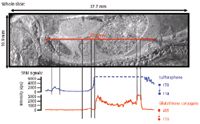
Figure 3: Tissue imaging often associated with MALDI is also being done with DESI and related techniques such as the surface sampling probe (SSP) developed by Van Berkel and co-workers shown here applied to a mouse tissue cross-section to localize administered drugs and their metabolites. (Courtesy Dr. Gary Van Berkel.)
Thermal desorption techniques can be limited, however, to what can be liberated from surfaces by heating. According to what we know today, ionization limits can follow those established for the two prominent techniques so far:
- APCI — moderate polarity; produces singly charged ions.
- ESI – for moderate-to-polar compounds; multiple charging is possible.
In its earliest stages, most work is being done via manual sample handling or crude automation. Spot sampling on surfaces clearly is possible. But imaging, being pursued by a number of leading practitioners in major pharmaceutical interests, is a more distant possibility hindered currently by a lack of resolution of the heated desorption–ionization plume. A good example of our current understanding of how this works, which includes video, is available at the ORNL Web site.
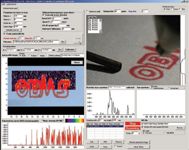
Figure 4: Real-time overlay of chemical and optical images obtained using HandsFree Surface Analysis imaging software developed by the ORNL group. Deposition on printed surfaces has allowed ORNL to reproducibly characterize response as changes are made to instrument designs. (Courtesy Dr. Gary Van Berkel.)
Imaging studies to map the location and behavior of drugs and their metabolites in living tissue is often associated with matrix assisted laser desorption techniques (MALDI) but is being investigated suing DESI and related techniques shown by Cooks' group and recently with a surface sampling probe (SSP) developed by Van Berkel and co-workers (Figure 3). The technology to obtain the necessary fidelity to the surface being characterized is being developed from work on printed and planar surfaces such as shown in Figure 4.
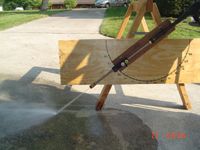
Figure 5: The handyman's DESI demonstration. (Courtesy Dr. Gary Van Berkel.)
The ability to image with good fidelity depends upon uniform surface-to-inlet consistency to avoid false readings. Surfaces that appear homologous are inconsistent enough to greatly disrupt the fidelity of the rastered, composite image. The group at ORNL developed HandsFree TLC–MS surface positioning control software, which automates sampling and imaging of analytes used with DESI. A high degree of control permits a number of real-time data visualization capabilities for spot sampling, array sampling, lane scanning and imaging, and real-time ion map displays and surface images, all of which can lead to on-the-fly signal optimization.
The compromises involved in DESI are illustrated by Van Berkel's clever study using something larger than the expected 1-μL/min, DESI-delivered stream directed against spots that are a mere few millimeters in diameter: a residential, high-pressure washer and chalk targets (representing a material weakly held on the deposition surface) and crayon targets representing a strongly held or retained analyte on the surface) (Figures 5–7).
As his work illustrates, the interaction of the plume (velocity, shape and angle) must be fit to the solvent strength relative to the analyte–surface interaction. In addition, we also must consider how the surface is imaged to ensure fidelity of the representative image to the sample surface.
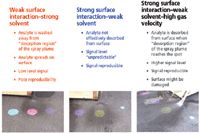
Figure 6: DESI analyteâsurface interaction. A number of interdependent, corresponding interactions determine desorption behaviors such as a weak or strong target compound when measured relative to its adsorption on the surface. (Courtesy Dr. Gary Van Berkel.)
Add spot-size relative to the plume, along with other "plume behaviors" such as velocity, angle, and spread of the plume and you get a sense of the complexity involved in achieving optimum results. Techniques like DESI hold great appeal for their ability to obtain a signal from an analyte bound to a surface, or to scan across a surface, and then generate a spatially resolved chemical image. They work for printed surfaces, analytes on thin-layer chromatography (TLC) plates, and endogenous compounds present in tissue. Nevertheless, unexplained discrepancies have been noted: for instance, between signals obtained for drugs versus their metabolites from dosed animals imaged in whole-body tissue sections using various techniques. Currently, sensitivity of 10× less than ESI is widely acknowledged. On balance, however, when studies are compared, significant differences in the design of experiments and their execution can exist that are not apparent without the most careful examination.

Figure 7: DESI analyteâsurface interaction. Strong interaction between the sample and the surface is necessary to ensure desorption efficiency. Sample: 1.8 ng rhodamine 6G piezospotted (220 μm spot diameter); surface scan rate: 100 μm/s. (Courtesy Dr. Gary Van Berkel.)
We do know that optimum settings of basic physical parameters in the source are critical to obtaining reproducible, quantitative data with proper spatial location and best readout resolution and, thus, the best obtainable image quality. These settings include
- Solvent, solvent flow rate, nebulizing gas linear velocity, and gas.
- Scan direction, scan speed, lane scan spacing.
- Angles and distances: spray, surface, atmospheric sampling capillary.
Not all answers have been deduced. Nor in some cases have the questions even been asked. Optimum settings for analysis of one analyte can differ for analysis of another. How universal or how selective is desorption–ionization under one set of conditions or all possible conditions? What matrix effects exist?
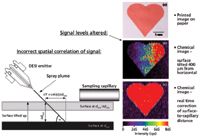
Figure 8: DESI capillary-to-surface distance. Scanning direction and the ability to follow subtle contours of the surface topology also plays a role in achieving resolution and fidelity in the acquisition portrayal of the ion target. (Courtesy Dr. Gary Van Berkel.)
Acknowledgment
Gary Van Berkel and Vilmos Kertesz provided much of the basis for this commentary and I am grateful for their efforts. Dr. Van Berkel is group leader of the organic and biological MS group at the Oak Ridge National Laboratory where, after receiving his Ph.D. from Washington State University, he started as a postdoctoral associate in 1987 under the guidance of Gary L. Glish and Scott A. McLuckey. Gary was awarded the Biemann medal in 2005 by ASMS which recognizes a significant achievement in basic or applied MS made by an individual early in his or her career. The award is presented in honor of Klaus Biemann, an early pioneer whose work spanned a 40 year period at the Massachusetts Institute of Technology and provided the basis for today's acceptance of MS. Dr. Vilmos Kertesz is a research staff member with the organic and biological MS group at the Oak Ridge National Laboratory. He received his Ph.D. from Eotvos Lorand University, Budapest, Hungary in 1997 and worked as a postdoctoral associate from 2004 to 2006 under the guidance of Gary Van Berkel.
Michael P. Balogh
"MS — The Practical Art" Editor Michael P. Balogh is principal scientist, LC–MS technology development, at Waters Corp. (Milford, Massachusetts); President and co-founder of the Society for Small Molecule Science which organizes the annual CoSMoS conference; and a member of LCGC's editorial advisory board.
References
(1) M.P. Balogh, LCGC 25(4), 368–380 (2007).
(2) M. Tomany and A.J. Jarrell, "Carbon Dioxide-Induced Atmospheric Sample Desorption and Analysis," 55th ASMS Conference on Mass Spectrometry, Indianapolis, Indiana, June 2007.
(3) S.C. Moyer and R.J. Cotter, Anal. Chem. 74, 469A–476A (2002).
(4) V.M. Doroshenko, V.V. Laiko, N.I. Taranenko, V.D. Berkout, and H.S. Lee, Int. J. Mass Spec. 221, 39–58 (2002).
(5) C.S. Creaser and L. Ratcliffe, Anal. Chem. 2, 9–15 (2006).
(6) J. Shiea, M-Z. Huang, H-J. Hsu, C-Y. Lee, C-H. Yuan, and I. Beech; J. Sunner Rapid Commun. Mass Spectrom. 19, 3701–3704 (2005).
(7) D.I. Carroll, I. Dzidic, E.C. Horning, and R.N. Stillwell, Appl. Spectrosc. Rev. 17, 337–406 (1981).
(8) C.N. McEwen, R.G. McKay, and B.S. Larsen, Anal. Chem. 77, 7826–7831 (2005).
(9) R.B. Cody, J.A. Laramee, and H.D. Durst, Anal. Chem. 77, 2297–2302 (2005).
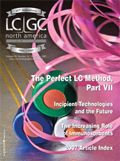
New Method Explored for the Detection of CECs in Crops Irrigated with Contaminated Water
April 30th 2025This new study presents a validated QuEChERS–LC-MS/MS method for detecting eight persistent, mobile, and toxic substances in escarole, tomatoes, and tomato leaves irrigated with contaminated water.

.png&w=3840&q=75)

.png&w=3840&q=75)



.png&w=3840&q=75)



.png&w=3840&q=75)







